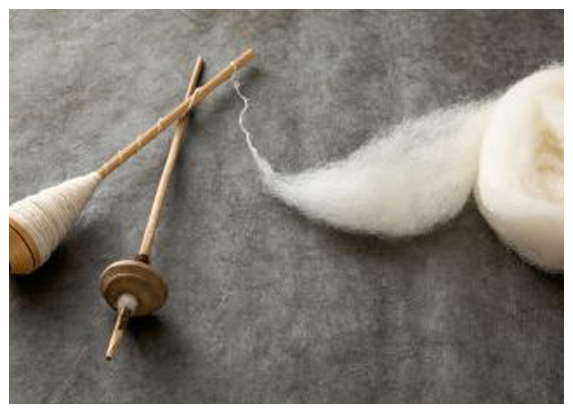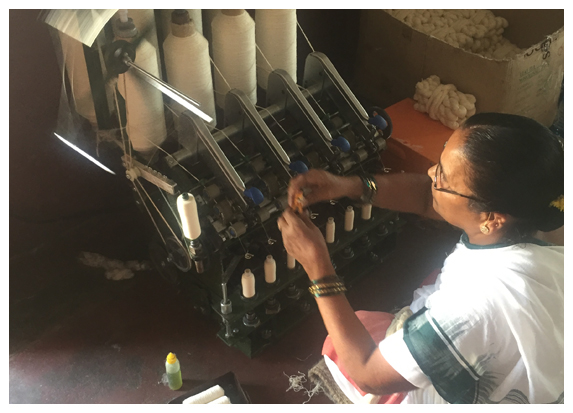Yarn was spun by hand for thousands of years using tools that were simple. The tedious labor was performed by almost every household in society. India has a glorious heritage of spinning fine count yarn, going up to fine counts of 500-1000 or above as in the case of the great muslin. Spinning is an activity which flourished in the villages mostly involving rural women. Till the onslaught of machine powered spinning (mill spun yarn ), handspinning remained a popular handicraft and livelihood.

The beauty of handspun, handwoven textiles is in the texture and inherent inequality. It is like each piece is almost customized.
Hand spinning is an old form of twisting together fibers to form yarn that can then be used to create clothing. Yarn was spun by hand for thousands of years using tools that were simple.It was only during the Middle Ages, that the spinning wheel was introduced, which made making spinning yarns much easier. The tedious labor was performed by almost every household in society in talkli, desi charka, Amber charka etc. With the exception of silk, all other natural fibers are obtained in the form of staple fibers. Different types of tools and techniques are used to introduce the required number of turns per length into a spun yarn.
Characteristics of spun yarn vary according to the material used, fiber length and alignment, quantity of fiber used, and degree of twist
India has a glorious heritage of spinning fine count yarn, going up to fine counts of 500-1000 or above as in the case of the great muslin. Spinning is an activity which flourished in the villages mostly involving rural women. Till the onslaught of machine powered spinning (mill spun yarn ), handspinning remained a popular handicraft and livelihoods.
Handspinning offers a lot of flexibility and the only limitation is the creativity and skill of the spinner. The quality of Yarn determines the quality of the fabric. Yarn count is an important index to distinguish the fineness of different yarns. Yarn count is the degree of yarn thickness. Skilled spinners can spin fine yarn counts from even very short staple cotton. Our native variety cotton, is short-staple cotton.
For over 2000 years Indians have grown, spun, woven and worn cotton and clothed other nations too in cotton. And the looms still continue to run in the 21st century, with no environmental damage, no disruption of society, no industrial pollution, no depredation of the earth’s resources. The process of weaving the handspun cloth itself is based on human energy which leaves the least carbon footprint.
Khadi and Handloom: Khadi or Khaddar is a fabric made with handspun yarn which is handwoven, whereas handloom fabric uses mill-spun yarn for handweaving. Khaddar is both hand spun and hand woven where as Handloom is only hand woven.
Thicker yarn is known as coarse counts and thinner yarn as fine counts. The count of thinner yarn is represented with higher numbers and thicker yarn is given lower numbers.
The low twist of handspun yarn helps it to unravel marginally every time the fabric is washed, giving it softness, a comfortable feel and a wonderful drape. It sits so well on our skin and breathes offering a greaer comfort and feel.
A handspun warp is delicate and needs the sensitive touch of human hands to manipulate the threads. It requires great deal of skill, concentration and patience to weave with a handspun warp.
Raw cotton from the farm is collected and is ginned where the lint is separated from the seed. This cotton is then thoroughly cleaned and then sent for combing & carding after which the cotton is made into slivers/roving. These slivers are then hand spun traditionally by using charkhas mostly by women in rural villages, thus offering an additional or main income for many rural Indian women.

The process of hand spinning saves nearly 40 gallons of water and uses less electricity.
Seen in the social context of generating self employment, in the words of Mahatma Gandhi: ‘I have no doubt in my mind that the wheel can serve as the instrument of earning one’s livelihood and at the same time enable the worker to render useful service to his neighbor. In order to ply the wheel intelligently, he should know all the processes that precede and succeed spinning.
Spinning originally was done using the Takli or the Desi (Manual) Charkha. The one that you would have seen Gandhiji work with. The art of spinning cotton on the Takli or the Desi Charkha is very meditative and beautiful. However, when it comes to women in villages using the same for earning a living, it is drudgery.
To reduce the drudgery and hardship in the spinning of the yarn as well as to improve the wage-earning ability of the spinners, the ambar charkha was invented. The Ambar Charkha is still operated by hand but the person operating is able to generate approximately 8 times of cotton yarn when compared to the desi charkha.
Later Solar Charkhas were introduced which use the sun’s energy to operate the Ambar Charkhas with a small motor. This in turn increases the productivity of the Ambar Charkha by 20%. This still requires manual effort although it reduces drudgery.
Whenever we say ‘Hand spun’ in this site, it could be fully hand spun using the Desi charkha, the
Ambar Charkha or the Solar Charkha.